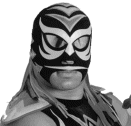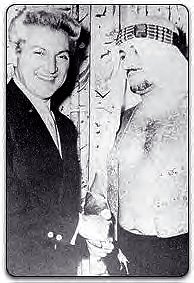|
Tribute
To The Sheik
01-20-03
Saturday
Morning, January 18th, 3:15am. Ed Farhat passes away at the
age of 78. That doesn't mean much to most fans of the mat
wars, but the wrestling of today came from matches Ed Farhat
had over his forty-year career. Ed Farhat was better known
as the Sheik, and the Sheik may be the true innovator of Hard
Core.
The Sheik
started out in the early TV wrestling boom of the 1950s. Trim,
tough, and excellent at getting the crowd to hate him, the
Sheik garnered huge ratings for his feuds with Johnny Valentine,
Buddy Rodgers, Antonino Rocca, Classy Freddie Blassie, and
his most famous early feud with the late Bobo Brazil. He acquired
many titles, including the NWA American Heavyweight Championship,
the number two title in the number one promotion in the World.
He traveled everywhere, sometimes performing in as many as
nine countries in a month, and half a dozen US states. He
brought his legendary brawling style around the world, and
become a mainstream star in Japan, Toronto, and of course,
his home base of Detroit.
On his
tours in the 1960s, he came toe to toe with the great Abdullah
the Butcher. Abdullah could match the Sheik for brutality,
and their feud, much like the Terry Funk/Mick Foley feud of
the 1990s, seemed to be more about proving who could dish
out and take more. These matches can be seen as the beginning
of the modern brawler style; truckloads of foreign objects
used in battles that raged around the ring, into the crowd,
and occasionally into the parking lot. These matches went
around the world, and some claim that their famous brawls
in Japan and Puerto Rico brought about the violent styles
that still exist on both islands to this day.
Farhat
ran the Detroit wrestling territory for almost twenty years.
While the territory became stale by the mid-1970s, it turned
a large profit many years and the television show Big Time
Wrestling often outdrew all other US wrestling programs. During
this period, the Sheik would wrestle as the top draw, often
bringing in older feuders such as Brazil, Abdullah, Blassie,
and Sweet Daddy Siki, and the top NWA stars such as a then-thin
Dusty Rhodes, Superstar Graham, The Funk family, and Harley
Race. Big Time Wrestling often featured the Sheik in cage
matches, chain matches, falls count anywhere melees, and barbed-wire
brawls. Watching Big Time Wrestling, you feel like it's ECW
in the late 90s, with matches that go long and violent.
|
|
|
Not even
Liberace could resist The Sheik.
|
Farhat
aged, ending Big Time Wrestling in 1980, but he continued
to travel the world, though he was over 50. He was a star
in Puerto Rico and Japan, and when Japanese mad man Atsushi
Onita started the ultra-violent FMW promotion, the Sheik and
his nephew Sabu were there. The Sheik competed in barbed-wire
matches, even though he was nearly 60 years old. His career
ended for the most part after a fire match in Japan. The fire
got too hot, and everyone else bailed, but the Sheik was having
trouble getting out and received severe burns. He later had
a heart attack, I believe in a Japanese taxi, and that put
the final nail in a career that spanned five decades.
Along
with the introduction of brawling as a basis for a promotion,
the Sheik also trained a great many stars of today, including
Sabu, Rob Van Dam, and Scott Steiner. It is no coincidence
that Sabu and Van Dam had a classic brawling feud in ECW.
The Sheik always loved that type of wrestling, and over the
years, he made several special appearances at shows around
the world, as the patron saint of the wild brawl. Without
Sheik, there is no Sandman, Mick Foley or Tommy Dreamer.
One of
the greatest tributes to the Sheik is a film made in the early
1980s called I like to Hurt People. Supposedly about a group
trying to ban the Sheik, the real reason this was made was
to highlight homemade rock played over the Sheik's greatest
matches. The tape also featured great interviews with Rhodes,
the Funks, and behind-the-scenes segments. Some call it amateurish,
but I think it's a perfect way to be introduced to the King
of Pain.
I doubt
the WWE will mention his passing, but the fact that they will
use a wild, object-laden brawl at some point is as good a
tribute as you can get to the man who started it all.
|







